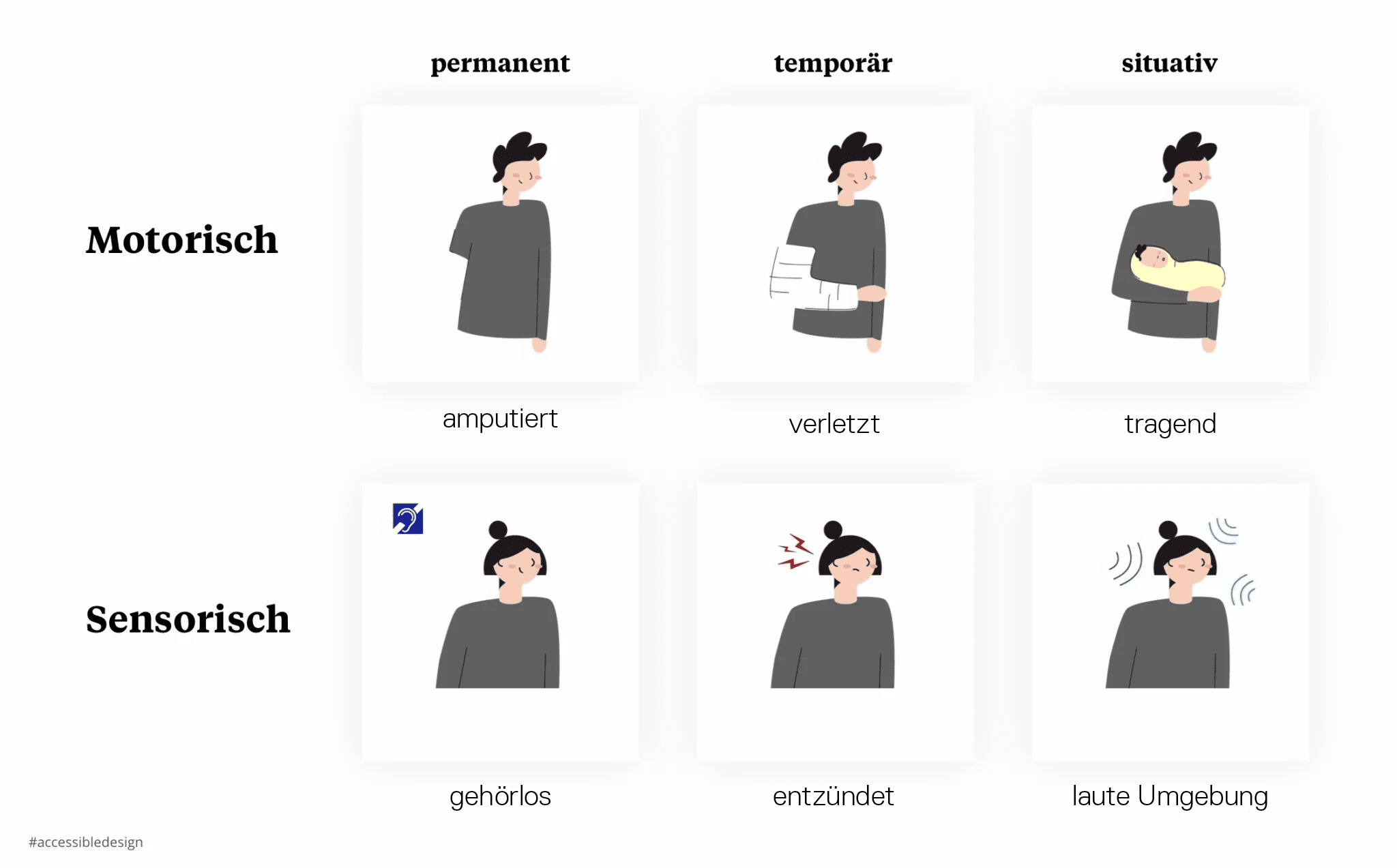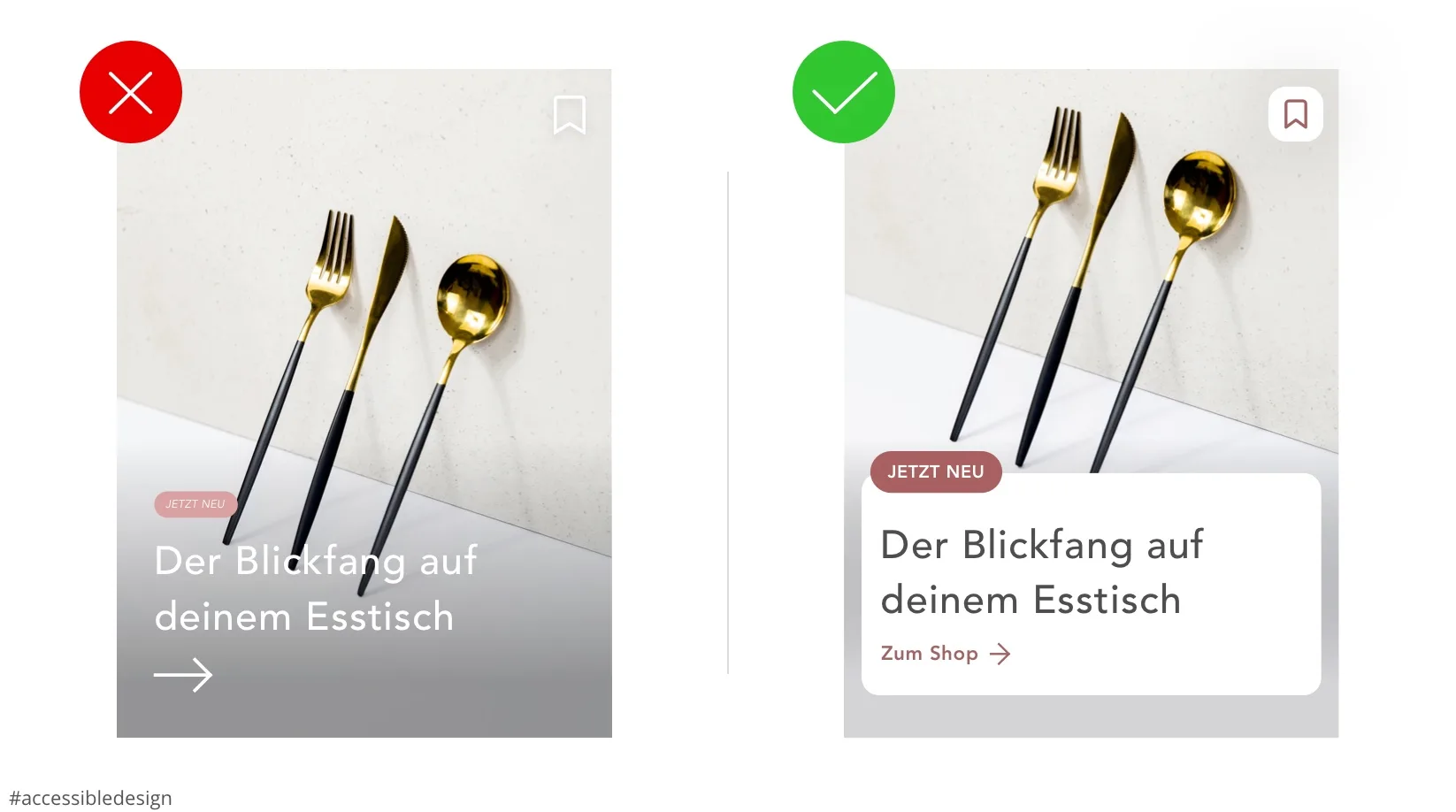Kreation
Accessible should be the new normal
Internet, Apps, Websites und digitale Services sind schon lange keine Neuheit mehr, geschweige denn ein Privileg. Sie sind ein essenzieller Bestandteil unseres Lebens – erst recht in Zeiten von Covid-19, New Work und digitalem Nomadentum. Wir haben uns schnell daran gewöhnt, dass sich ein Großteil unseres Lebens online abspielt und wir wichtige Dinge digital abwickeln – vom Job bis hin zum Bankgeschäft. Das fängt schon bei den Jüngsten an, die mittlerweile auch über den Bildschirm unterrichtet werden.

Als Designer und als Auftraggebende von neuen (digitalen) Produkten haben wir eine besondere Verantwortung: Produkte so zu gestalten, dass sie für Menschen aller sozialer Schichten, in allen Lebenssituationen und mit gesundheitlichen oder körperlichen Einschränkungen konsumierbar sind. Also kurz: Für alle Menschen funktionieren. Hier nicken Sie vermutlich mit dem Kopf. Doch die Praxis zeigt: Der Ansatz „People first“ oder „Human (User) Centered Design“ zielt meist noch auf den normativen, neurotypischen Menschen ab und vergisst diejenigen, die in irgendeiner Form körperlich eingeschränkt oder anders befähigt sind. In diesen Fällen scheitert ein Produkt daran, die Bedürfnisse seines Users zu erfüllen. Es wird zur Hürde statt zur Lösung.
Profitieren aber ausschließlich Menschen mit Behinderung von Barrierefreiheit?

Beispiele für motorische und sensorische Einschränkungen (v.l.n.r):
Amputation, Bruch, physische Belastung; Gehörlosigkeit, Entzündung oder Störgeräusche
Barrierefreiheit betrifft aber nicht nur das Design, sondern auch den Text. Denn viele Inhalte sind so kompliziert formuliert, dass Nutzer sie nicht vollständig verstehen – etwa aufgrund mangelnder Sprachkenntnisse, geistiger Einschränkungen oder situativer Gegebenheiten. So kann es passieren, dass sie ein Produkt nicht bestellen oder falsch anwenden, Chancen verpassen oder rechtliche Konsequenzen tragen müssen. Texte in einfacher Sprache vermeiden Missverständnisse und geben mehr Menschen Zugang zu relevanten Informationen.
Machen wir uns unsere Verantwortung daher bewusst: digitale Produkte müssen inklusiv sein. Wir möchten keine Hürden bauen, wir möchten sie einreißen!
In großen Unternehmen ist Barrierefreiheit bereits ein Grundpfeiler in der Produktentwicklung und Teil der Unternehmensstrategie. In vielen kleineren Unternehmen ist das Konzept und dessen Relevanz allerdings noch nicht komplett angekommen. Sie haben zwar verstanden, dass Websites von Krankenhäusern und öffentlichen Einrichtungen barrierefrei sein müssen, sehen den Bedarf aber nicht beim technischen Mittelständler oder dem Kleingewerbe im Nachbarort . Obwohl ein für Menschen entwickeltes Produkt an sich für alle Menschen funktionieren sollte, gibt es noch genug Applikationen und Websites, die für viele schlichtweg nicht verwendbar sind. Das betrifft vor allem die Unternehmen, die keine globalen Player sind. Also den Großteil. Aber woran liegt das?
Diese Stolpersteine torpedieren ein inklusives Produkt bereits in frühen Projektphasen:
- Zielgruppenbeschreibungen, Personas, etc., die gesundheitliche Beeinträchtigungen vernachlässigen
- Der Glaube, die eigene Website werde nur von gesunden, voll konzentrierten
Menschen in ideal beleuchteten Situationen besucht - Das Vorurteil, Barrierefreiheit koste mehr Geld in der Entwicklung
- Die Überzeugung, nur Menschen mit gesundheitlicher Beeinträchtigung profitierten von Barrierefreiheit
- Use Cases, die Szenarien mit beeinträchtigter Nutzung ignorieren
- Die Priorisierung von Ästhetik und Image vor Usability und User Experience
Vermeiden Sie diese Faktoren und sorgen Sie dafür, dass Barrierefreiheit von Anfang an
eine zentrale Rolle in Ihren Projekten spielt. Denn jeder User zählt für Ihren Erfolg.
Der größte Take Away dieses Artikels ist wahrscheinlich auch die größte Überraschung:
Eine barrierefreie Website hat immer eine bessere Usability als eine nicht-barrierefreie
Website. Sie profitieren also immer von einer inklusiven Umsetzung. Dieses Bewusstsein hilft Ihnen auch dabei, die Customer Experience Ihrer Kunden generell zu erhöhen. Aber der Reihe nach. Lassen Sie uns kurz mit den obengenannten Stolpersteinen sowie Vorurteilen aufräumen und die Vorteile von Inklusion bzw. Barrierefreiheit betrachten:


Eileen ist Leiterin des UX-Team bei port-neo in Stuttgart. Ihr Spezialgebiet ist UX-Design. Dabei kreiert sie schnieke User Experiences und Interfaces für Websites und Apps. Mit Ihrem Gespür für Trends und Innovationen sorgt sie dafür, dass unsere Kunden immer mit der Zeit gehen.
LEISTUNGSPORTFOLIO
